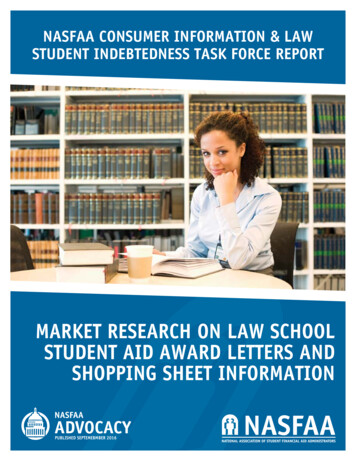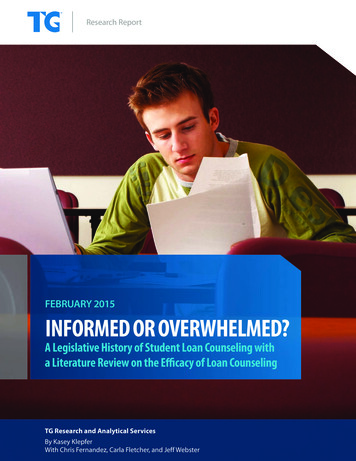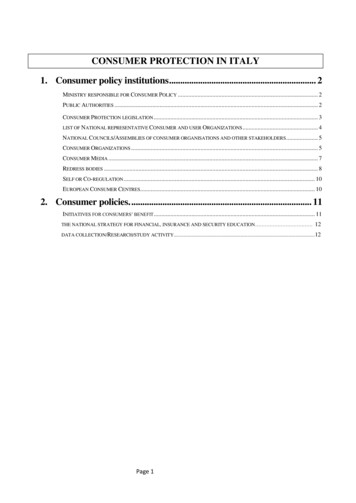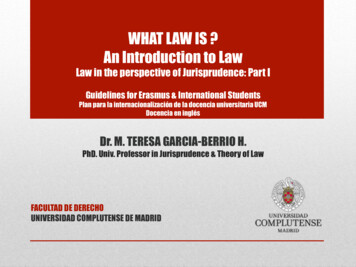
Transcription
NASFAA CONSUMER INFORMATION & LAWSTUDENT INDEBTEDNESS TASK FORCE REPORTMARKET RESEARCH ON LAW SCHOOLSTUDENT AID AWARD LETTERS ANDSHOPPING SHEET INFORMATIONPUBLISHED SEPTEMEBMBER 2016
Table of ContentsAcknowledgements.4Executive Summary.5Foreword by endations.29Conclusions.33Appendix A: MethodologyResearch Objectives.34Data Collection.34Site and Participant Recruitment.35Focus Group ve Data Analysis.40Limitations.41Appendix B: Award Letter and Shopping Sheet Mockups.42Appendix C: Sample Questionnaire.58Appendix D: Focus Group Protocol.70Appendix E: References.72NASFAA is the largest postsecondary education association with institutionalmembership in Washington, D.C., and the only national association with a primaryfocus on student aid legislation, regulatory analysis, and training for financial aidadministrators in all sectors of post-secondary education. No other national associationserves the needs of the financial aid community better or more effectively.
AcknowledgementsWe would like to thank Access Group for their generous support of this important research. We would also like to thank thehigher education institutions and their students for participating in our consumer testing.The research was done by Coffey Consulting on behalf of National Association of Student Financial Aid Administrators(NASFAA).About NASFAANASFAA is a nonprofit membership organization that represents more than 20,000 financial aid professionals at nearly3,000 colleges, universities, and career schools across the country. NASFAA member institutions serve nine out of every 10undergraduates in the United States. Based in Washington, DC, NASFAA is the only national association with a primaryfocus on student aid legislation, regulatory analysis, and training for financial aid administrators. For more information, visitwww.nasfaa.org.Task Force MembersChair: Gina Soliz, Syracuse University College of LawKatherine Anderson, MGH Institute of Health ProfessionsCheryl Constantine, Boston University School of LawJohn Garcia, Michigan State University College of LawDavid Schrock, The Catholic University of America Columbus School of LawTracy Simmons, University of the Pacific, McGeorge School of LawJared Smith, The George Washington University School of LawLindsey Stetson, The University of Michigan Law SchoolNASFAA Staff LiaisonsCharlotte EtierKaren McCarthy4The National Association of Student Financial Aid Administrators - 2016
Executive SummaryNow more than ever, financial aid information plays a key role in a student’s college enrollment decision – particularly at thegraduate level. While there is a plethora of financial aid information available for prospective and current undergraduatestudents and their parents, the resources specifically targeting students in graduate professional programs, such as law,are more limited. Moreover, the effectiveness of these materials at clearly communicating financial aid award informationand concepts to graduate students has not been studied. The National Association of Student Financial Aid Administrators(NASFAA) and its Consumer Information & Law Student Indebtedness (CILSI) Task Force, with a grant from Access Group, Inc.,sought to fill this gap in the research by testing financial aid award materials with a diverse group of prospective law studentsand current law students enrolled in accredited law school programs. In 2015, NASFAA contracted Coffey Consulting, LCC, anindependent research firm, to test two financial aid award letters and two Shopping Sheets: Award Letter A and Award Letter B were both developed by the NASFAA CILSI Task Force. Award Letter A included thefinancial aid award information in the body of an email. Award Letter B provided a brief paragraph acknowledging that thefinancial aid request had been processed and hyperlinks to an online “student portal” that contained more detailed awardinformation. Shopping Sheet A was the U.S. Department of Education’s (ED) one-page Financial Aid Shopping Sheet. Shopping Sheet Bwas a one-page document developed based on the recommendations from the NASFAA CILSI Task Force and NASFAA’sprevious study on award letters (NASFAA, 2013).Coffey conducted online and in-person focus groups with students at four public and 12 private institutions. All of the inperson focus groups were held in the Northeast and Mid-Atlantic regions. The online focus groups allowed for more diversityin terms of location, and included participants from institutions located in the Northeast, the South, the Midwest, and theWest. After reviewing the proposed award letters and the Shopping Sheets, Coffey invited participant feedback and opinionson the level of clarity of financial aid calculations and concepts in each document, the features participants found helpful orconfusing, and suggestions for improvement. Participants were also asked to complete a comprehension questionnaire tobetter understand to what extent they were able to draw accurate conclusions about the aid awarded in each financial aidscenario.Of the two award letters, participants across student and institution types seemed to prefer Letter B as the clearest andeasiest to comprehend. Sixty percent of respondents selected Letter B as their preference among the two award letters,although less than half found that either letter clearly communicated the information. While focus group participants felt thatLetter B offered a good balance between useful numbers, text, and visual formatting, there were also elements of LetterA they appreciated, such as its upfront presentation of the aid awarded (instead of a link to an online portal). Of the twoShopping Sheets, a large majority (78 percent) preferred Shopping Sheet B, the version developed by the Task Force. Again,as with the award letters, approximately half or less of respondents found the Shopping Sheets to be clear on a variety ofmeasures.The questionnaire revealed that participants’ comprehension levels of the financial aid concepts presented on both sets ofdocuments were quite mixed. The majority of respondents were able to correctly identify the amount of scholarships availableand the other types of financial aid explicitly awarded in the letter. However, few correctly estimated the total amount ofloans available, since some types of loans were not pre-packaged in the documents (i.e., the Graduate PLUS loans). Themajority understood the next steps needed to receive financial aid based on information from both financial aid award letters.In contrast, the Shopping Sheets showed a discrepancy in the percentage of participants who indicated they were able tounderstand what steps they needed to take next to receive financial aid; only 30 percent of respondents indicated knowingthe next steps based on Sheet A (ED’s Shopping Sheet), while the majority (80 percent) felt that Sheet B (the preferreddocument) clearly conveyed this information.Market Research on Law School Student Aid Award Letters and Shopping Sheet Information5
The alarmingly low correct response rate to questions about maximum loan amounts available and the amount needed tocover direct and indirect costs shows that consumers will take the information provided on the documents at face value. Theywill not necessarily read the fine print and realize that additional funds are available beyond those being formally awarded,as stated in the financial aid documents. These questions required a deeper understanding of the subtleties and nuancesaround information provided in the letter. Consumers reading these financial aid documents may not have the time to makethese inferences, or may not thoroughly understand the financial aid process, and would need this type of information moreexplicitly stated. The mixed results in terms of document preferences and comprehension levels also suggest the need forpersonal financial aid counseling along with the information provided in these documents to help students interpret andjudiciously act on the options available.Focus group participants offered similar suggestions for additions to both sets of documents, including: definitions forfinancial aid terms; important deadlines and a timeline for the financial aid process; terms and conditions, particularly for loans;information about PLUS loans and loan repayment; and information on private financial aid options. The strong preference forthe Task Force’s Shopping Sheet (Sheet B) suggests that perhaps the current standard Shopping Sheet for undergraduatesis not the best fit for law students and, possibly, other students in graduate professional programs. In other words, theinformation conveyed through the Shopping Sheet is not necessarily “one-size-fits-all” when it comes to the wide range ofstudent characteristics and experiences.Coffey Consulting, March 20166The National Association of Student Financial Aid Administrators - 2016
Foreword by NASFAANASFAA has held a longstanding commitment to the Graduate/Professional (G/P) community. Two issues of increasingconcern to our G/P members are G/P education affordability and student loan debt. Policymakers have responded tomounting student loan debt by requiring increasing amounts of consumer information for students. Unfortunately, thisconsumer information is untested and, as it is generally targeted to undergraduates, rarely addresses the unique needs of G/Pstudents. As a result, G/P students may make poor education financing decisions and/or fail to enroll due to lack of relevantconsumer information.NASFAA contracted Coffey Consulting to consumer test award letters, including the U.S. Department of Education’s (ED)Shopping Sheet, to determine what consumer information is most helpful to G/P students, specifically law students, in makinginformed borrowing decisions and encouraging enrollment in, and completion of, law and other G/P programs. This reportcaptures the perspectives and opinions of current and prospective law students.Coffey Consulting identified several important findings from the study participants. Overall, there was mixed to lowunderstanding of general financial aid concepts, the difference between direct and indirect costs, and the amount of availableloan funding. Based on the results from this study, NASFAA presents four recommendations:Recommendation 1: Software developers should develop a calculator to help students determine the amount they needto borrow while enrolled. The results of our research showed that common current award notification structures (format,delivery, etc.) are not serving students well in terms of increasing their knowledge of loan availability and other indebtednessissues. Incorporating a calculator into the self-service portal of the major software providers would help educate studentsby providing personalized information such as the total cost of the academic program, a yearly breakdown of estimatedborrowing, and the total estimated borrowing for the academic program.Recommendation 2: G/P schools should move toward standardizing financial aid terminology used as well as the presentationof information, and ED should develop a portal through which information is shared with students. Students should have easyand immediate access to a plain-language glossary of financial aid terms. Award letters from various institutions could presentfinancial aid information in slightly different ways, but unified, consistent financial aid terminology is critical for students tounderstand. Based on the NASFAA Task Force recommendation, a “Glossary of Terms” would contain universally accepteddefinitions of language typically contained on award notifications. The goals of a universal glossary would be to providecommonly defined and accepted terms, give students greater clarity and understanding through the use of consistent terms,and improve prospective students’ ability to compare award information from multiple schools.Based on the results of the study, the task force also recommends several core elements that should be included in all awardnotifications, such as links to general information about debt and repayment, and terms and conditions of awards. Awardletters that include some of the same standardized information, modified as necessary to reflect students’ individual needs,will result in more students being better informed and more easily able to understand the bottom line.A common portal, developed by ED, would provide prospective students a common source for all award letters, alongwith links to school-specific information. Although logistically challenging to implement, such a portal would aid students incomparing aid offers from different institutions.Recommendation 3: Additional consumer testing is needed to determine if G/P students understand basic financial aidterminology and concepts, and the terms & conditions of the financial aid offered in their award letters. The results ofthe current consumer testing on award letters revealed a possible comprehension gap that warrants further study. Studyparticipants overall were lacking in general knowledge about financial aid terminology and concepts, elements of an awardletter, and cost of attendance. Additional consumer testing in this area could aid in overall efforts to improve the awardnotification process by more finely pinpointing students’ levels of knowledge and areas in which their knowledge may belacking.Recommendation 4: G/P institutions should list Graduate PLUS Loan eligibility on a student’s award letter. The low correctresponse rate to questions about maximum loan amounts, especially Graduate PLUS eligibility, prompted the task force toexamine the advantages and disadvantages to “packaging” Grad PLUS (i.e., listing the student’s maximum PLUS eligibilityas part of the financial aid package). Their recommendation is that maximum Graduate PLUS loan eligibility should be listedon the award letter, separate from the rest of the aid package, along with the math calculations used to derive that loaneligibility.Market Research on Law School Student Aid Award Letters and Shopping Sheet Information7
There are potential negative consequences of not providing any PLUS Loan eligibility amounts on the award letter, namelyan unawareness of the availability of the PLUS Loan program and possible resulting use of less advantageous private loans.However, there are also concerns about potential negative consequences of including the student’s full PLUS Loan eligibilityas part of the financial aid package, namely that students may make hasty decisions to borrow the maximum eligibility ratherthan carefully considering how much is truly needed. This recommendation seeks to avoid both sets of potential negativeconsequences by making students aware of the Federal Direct PLUS Loan Program, and illustrating the student’s maximumloan eligibility along with instructions on how to apply, but without the automatic nature of packaging the PLUS Loan.Providing current and future G/P students with clear and understandable information about the cost of college and the aidavailable to them to meet those costs has become increasingly important as tuition and other associated costs of collegehave increased faster than family incomes. Identifying what type of award letter information is most helpful or favorable tounderrepresented G/P students, specifically law students, will help this population to understand the long-term financialoutcomes of obtaining their desired degree, and make better-informed decisions.The recommendations in this report would make award letters more clear and understandable, and help students understandcosts and the available financing options. However, it is important to note three things. First, the knowledge gap on keyfinancial aid concepts uncovered by this study indicates that there is much work to be done to increase student understandingof these issues.Second, the varying preferences expressed by the study participants in areas such as format and content should steer us awayfrom attempting to create a one-size-fits-all standardized award letter. This study and NASFAA’s previous related research onundergraduate students point us to the same conclusion: one-size-fits-all is not a workable solution.Third, the award notification process is only one step in the student loan process. Since the award notification can be thestudent’s first exposure to the loan process and is presented at a critical decision point for the student, it is important thatthe award notification provide clear, easy to understand, and helpful information to the student. However, there are manyother “touch points” along the lifecycle of a student loan that are learning opportunities for the student, so we should resistthe temptation to provide more and more information through the award notification process. This only serves to overwhelmand confuse students. Instead, we should view the award notification process as one step of many in the course of a student’seducation on student loan debt.8The National Association of Student Financial Aid Administrators - 2016
BackgroundThe Graduate Student Financial Aid SettingWhile much attention has been paid to undergraduate financial aid reform, the unique financial experiences of studentspursuing advanced degrees have gone largely unstudied. Graduate students comprise less than 15 percent of the totalenrollment in postsecondary institutions (Baum, Ma, Pender, & Bell, 2015), but account for a disproportionate 40 percentof nationwide borrowing (Delisle, 2014). Important stakeholders, such as New America, Access Group, NASFAA, YoungInvincibles, the National Association of Graduate-Professional Students, and the Council of Graduate Schools, have recentlytaken a closer look at the graduate financial aid landscape with a goal to improve financial literacy among these students.The financial aid landscape for graduate students in particular has changed over the past decade, with the introduction ofGraduate PLUS Loans (now Direct PLUS Loans) in 2006 and the removal of federal subsidized loans in 2012. Historical trenddata from the College Board indicate that graduate students typically borrow substantially larger amounts of federal loanmoney, receive more grant aid (College Board, 2015), and have different loan options (Baum et al., 2015) than undergraduatestudents. While undergraduate borrowers have stricter loan limits, “federal programs allow grad students to borrowessentially unlimited amounts – whatever their schools charge – while requiring only a scant credit check and no assessmentof their ability to repay” (Mitchell, 2015, n.p.). As a result of the unique environment in which graduate students receive andprocess financial aid information, it is important that they are well-informed about the contents of aid packages, and areprovided with financial aid award materials that can be easily and accurately interpreted.Recent research on graduate students has illuminated room for improvement regarding financial education (Stone et al.,2015). The Access Group, who funded this study, recently surveyed financial aid administrators at graduate schools to betterunderstand the context in which graduate students are making complex financial decisions, and found that “financial aidoffices are providing financial education programs and services using limited staffing, self-taught knowledge, and most oftenwithout additional financial resources or significant cooperation from peers and campus administration” (Stone et al., 2015,p. 6). These findings further support the need to provide better resources to graduate students who are borrowing largeamounts of federal dollars.Research also suggests that graduate financial aid and loan debt is related to persistence (Gururaj, Heilig, & Somers, 2010;Jaschik, 2007; Strayhorn, 2010), which is an especially important consideration for graduate students, as estimates ofdoctoral program dropout rates have previously reached 50 percent (Gururaj et al., 2010). Based on findings from the Ph.D.Completion Project, a seven-year study of students at 29 universities, providing financial support is considered a “promisingpractice,” as 80 percent of Ph.D. completers considered it to be a “main factor” in promoting completion (Jaschik, 2007).Moreover, Gururaj et al.’s (2010) meta-analysis of three studies on graduate student financial aid found that the receipt ofany financial aid increased the likelihood of within-year persistence by 9 percent. In terms of loan debt, Gururaj et al. (2010)also reported that, “for every 1,000 in loans, students were 7 percent more likely to persist in graduate school” (p. 41), andStrayhorn (2010) found a significant positive relationship between loan borrowing and persistence. His research warned,however, that a “tipping point” might exist regarding persistence and level of loan debt, finding that “those who borrowedless were nearly five times more likely to persist than those who borrowed over 40,000” (Strayhorn, 2010, p. 17).Despite these nuances particular to graduate students, some of the educational context for graduate students mirrors thatof the undergraduate landscape. Like undergraduate tuition (Ma, Baum, Pender, & Bell, 2015), the average cost of tuition atgraduate schools has continued to increase over the last 20 years (Woo & Shaw, 2015). Furthermore, trends in the net costof tuition have also paralleled those of undergraduate schools in that a growing gap exists between the sticker price and theamount students actually pay (Woo & Shaw, 2015), underscoring the importance of providing understandable bottom-lineestimates of cost of attendance.Spotlight on Law StudentsStudents pursuing professional degrees represent a particularly important group of graduate students in that these degreeprograms are typically the most expensive and, as a result, the degrees for which students receive the most financial aid (Woo& Shaw, 2015). Recently, the substantial amount of debt that students are undertaking to pursue these degrees has garneredsignificant media attention. The New York Times referenced one typical law student’s debt as a potential “catastrophicinvestment” (Segal, 2011, n.p.), while The Wall Street Journal referred to a similar debt level as a “small fortune” (Mitchell,2015, n.p.), and Time magazine labeled graduate student debt “the real student debt problem no one is talking about”(Marcus, 2014, n.p.).Market Research on Law School Student Aid Award Letters and Shopping Sheet Information9
Like other graduate students pursuing professional degrees, law students face an educational environment in which thecost of tuition continues to rise (Access Group, 2015; American Bar Association, n.d.; Baum, 2015). However, the stakes areparticularly high for this population of degree-seekers, as law students faced the second-highest average tuition across allgraduate students in 2011-12, surpassed only by medical school students (Woo & Shaw, 2015). In addition, debt levels forlaw school students continue to grow alongside tuition (Access Group, 2015; Baum, 2015; Delisle, 2014). In 2012, law schoolgraduates had an average debt amount of 140,616 (Delisle, 2014); meanwhile the median salary for law school graduatesemployed in private practice declined substantially (Access Group, 2015).A closer look at law school student aid patterns reveals some important information. First, the vast majority of law schoolstudents – 88 percent in 2011-12 – receive student aid (Woo & Shaw, 2015). Federal loans make up the majority of financialaid for these students; the average law student enrolled in 2011-12 borrowed 40,400 during the academic year and hada cumulative loan debt of 104,400 (Woo & Shaw, 2015). Furthermore, more than three quarters of the law students whoreceived Direct PLUS loans during this time borrowed the maximum amount (Woo & Shaw, 2015). Lastly, graduate studentsin professional schools “are less likely to receive graduate assistantships, institutional funding, or employer-provided tuitionassistance” (Belasco, Trivette, & Webber, 2014, p. 487) than students pursuing master’s degrees.Financial Aid TransparencyProviding transparent, understandable information to students and families regarding the bottom-line costs of college andfinancial aid options has become a key concern, as tuition prices have increased more quickly than family incomes and debtlevels have grown. The Higher Education Opportunity Act (HEOA) of 2008, which reauthorized the Title IV federal student aidprograms outlined in the Higher Education Act of 1965, emphasized college affordability, reducing the cost of attendance,and providing better information about college costs, including estimated net price. Many student advocacy organizationshave supported efforts to improve award letters, including NASFAA, the National Association of College AdmissionsCounselors (NACAC), the National College Access Network (NCAN), and The Institute for College Access and Success(TICAS). While key stakeholders agree that financial aid award letters must be easier to understand in order to supportstudents’ decision-making, colleges and universities are still debating the specific content and format of the letter.Recent research by NERA Consulting highlighted the need for improved transparency. In 2012, NERA reported that of the“high-debt” undergraduate and graduate students surveyed, a quarter of whom owed more than 100,000, “about 65percent misunderstood or were surprised by aspects of their student loans or the student loan process” (Whitsett, 2012, p.2). The respondents also reported confusion in comparing federal and private loan options, repayment options, and interestrates. Importantly, “this survey suggests there is also a severe shortage in ‘preventative’ measures taken by schools, lenders,legislators and regulators, and consumer advocacy organizations to ensure that borrowers are provided with key informationupfront so they understand their rights, obligations, and available options” (Whitsett, 2012, p. 2).Development of Standardized Award LettersA movement to standardize financial aid award letters has surfaced as a result of the increased focus on financial aid reform.Both Sen. Al Franken (D-MN) and Sen. Tom Harkin (D-IA) introduced legislation that mandated the implementation of astandardized award letter (NASFAA, 2014),1 although there was little movement in Congress on either. In 2012, ED unveiledits proposed Financial Aid Shopping Sheet that was intended to serve as a tool for students and families to easily comparestudent aid packages.2 ED subsequently released a revised version that incorporated user feedback, such as the additionof a glossary of terms with which students may be unfamiliar (Dann-Messier, 2013). The Obama administration has sinceencouraged all colleges and universities to begin using its proposed Shopping Sheet beginning with the 2013-14 academicyear, and according to ED, more than 2,900 postsecondary institutions have done so as of April 2015.3Howeve
John Garcia, Michigan State University College of Law . McGeorge School of Law Jared Smith, The George Washington University School of Law Lindsey Stetson, The University of Michigan Law School NASFAA Staff Liaisons Charlotte Etier . mounting student loan debt by requiring increasing amounts of consumer information for students .










